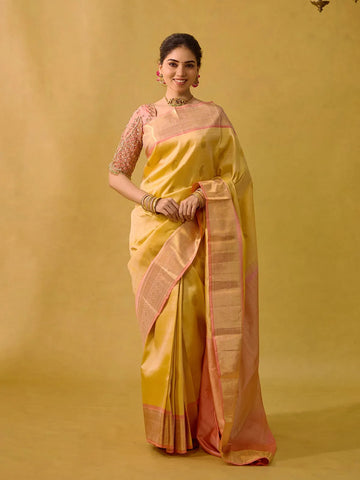
Difference Between Banarasi and Kanchipuram Sarees: What to Know Before You Buy
When it comes to luxurious silk sarees in India, two names dominate every bridal and festive wardrobe: Banarasi and Kanchipuram. Though both are celebrated for their grandeur, heritage, and craftsmanship, they come from entirely different weaving traditions. If you're unsure which to choose or want to understand what sets them apart, this guide will help you make a confident decision.
What is a Kanchipuram Saree?
Originating from the temple town of Kanchipuram in Tamil Nadu, Kanchipuram silk sarees are known for their durability, rich texture, and elaborate zari work. These sarees are handwoven with pure mulberry silk and typically have contrasting borders joined with the body using a traditional technique called korvai.

Motifs often include temple borders, peacocks, elephants, and other South Indian iconography. They're ideal for muhurthams, weddings, and religious ceremonies. Discover pure Kanchipuram sarees that reflect heritage and grace.
What is a Banarasi Saree?
Banarasi sarees come from Varanasi (Banaras) in Uttar Pradesh and are famed for their intricate brocade work and Mughal-inspired motifs. Woven using finely spun silk threads and metallic zari, these sarees exude opulence.

Popular designs include floral vines, jhallar borders, Mughal jaal patterns, and mina work. Banarasi silk sarees are often chosen for receptions, formal events, and North Indian weddings. Their intricate craftsmanship and fluid drape make them a versatile luxury staple.
Key Differences Between Banarasi and Kanchipuram Sarees
Kanchipuram sarees are woven with thicker silk, making them heavier and more structured, while Banarasi sarees use lighter silk and have a softer drape. The motifs in Kanchipuram silk sarees are rooted in temple art, whereas Banarasi designs borrow from Persian and Mughal elements.
The weaving techniques also differ. Kanchipuram sarees often use the korvai method, joining borders separately, while Banarasi sarees are known for their all-over zari brocade.
When to Choose Which?
Choose a Kanchipuram saree for temple weddings, traditional muhurtham rituals, and South Indian ceremonies where grandeur and heritage are key.
Go for a Banarasi saree for receptions, cocktail events, or sangeets — occasions where elegance meets ease of draping. Still unsure? Compare our Banarasi vs. Kanchipuram collections to find what speaks to your style.
Why Diadem Offers Both
Diadem celebrates the richness of India’s textile legacy. Our curated collection includes certified handwoven Kanchipuram silk sarees and ornate Banarasi sarees that represent the finest craftsmanship from their respective regions.
Each saree is selected for its authenticity, elegance, and wearability — whether you're a bride, bridesmaid, or a guest. Explore Diadem’s Kanchipuram collection or browse Banarasi sarees online to find your perfect drape.
Final Word
Both Banarasi and Kanchipuram silk sarees are masterpieces of Indian heritage. Choosing between them isn’t about which is better, but rather which aligns with your celebration, personality, and tradition.
Visit www.diademstore.com to discover a world of bridal and festive silk sarees that define timeless elegance.
Frequently Asked Questions
- Which is heavier, Banarasi or Kanchipuram saree – Kanchipuram sarees are generally heavier due to their thicker silk and dense weave
- Can Banarasi sarees be worn for South Indian weddings – Yes, Banarasi sarees are elegant choices for receptions and sangeet
- Is the zari used in both types real – In handwoven versions, yes. Diadem offers sarees with authentic tested zari
- Are Kanchipuram sarees always made with korvai joins – Traditionally, yes. The korvai technique is a key feature of Kanchipuram craftsmanship
- Which is more expensive – Both are premium, but Kanchipuram sarees generally cost more due to silk weight and weaving effort

